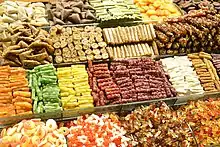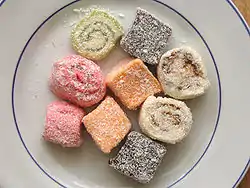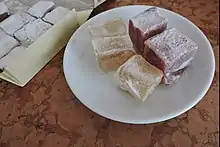 An assortment of Turkish delight on display in Istanbul | |
| Alternative names | Lokum |
|---|---|
| Type | Confection |
| Place of origin | Ottoman Empire (Turkey),[1] or Safavid Empire (Iran/Persia)[2] |
| Serving temperature | Room temperature |
| Main ingredients | Starch, sugar[3][4][5] |
| Ingredients generally used | Fruit, nuts, honey |
| Variations | Multiple |
Turkish delight or lokum (Turkish pronunciation: [lɔ.kʊm]) is a family of confections based on a gel of starch and sugar. Premium varieties consist largely of chopped dates, pistachios, hazelnuts or walnuts bound by the gel; traditional varieties are often flavored with rosewater, mastic gum, bergamot orange, or lemon. Other common flavors include cinnamon and mint. The confection is often packaged and eaten in small cubes dusted with icing sugar, copra, or powdered cream of tartar to prevent clinging. In the production process, soapwort may be used as an emulsifying additive.
The origin of Turkish delight is not precisely known, but the confection is known to have been produced in Turkey and Iran (Persia) since the late 18th century.
History




.JPG.webp)

The exact origin of these sweets is yet to be definitively determined. According to the Hacı Bekir company, Bekir Efendi, named Hacı Bekir after performing the Hajj, moved to Constantinople from his hometown Kastamonu and opened his confectionery shop in the district of Bahçekapı in 1777. He produced various kinds of candies and lokum, later including a unique form of lokum made with starch and sugar. The family business, now in its fifth generation, still operates under the founder's name.[6]
Tim Richardson, a historian of sweets, has questioned the popular attribution of Hacı Bekir as the inventor of Turkish delight, writing that "specific names and dates are often erroneously associated with the invention of particular sweets, not least for commercial reasons".[2] Similar Arab and Persian recipes, including the use of starch and sugar, predate Bekir by several centuries.[7] The Oxford Companion to Food states that although Bekir is often credited with the invention, there is no hard evidence for it.[8]
Name
The Turkish names lokma and lokum are derived from the Arabic word luqma(t) (لُقْمَة) and its plural luqam (لُقَم) meaning 'morsel' and 'mouthful'[9] and the alternative Ottoman Turkish name, rahat-ul hulküm,[10] was an Arabic formulation, rāḥat al-hulqūm (رَاحَةُ ٱلْحُلْقُوم), meaning 'comfort of the throat', which remains the name in formal Arabic.[11] In Libya, Saudi Arabia, Algeria and Tunisia it is known as ḥalqūm, while in Kuwait it is called كبده الفرس kabdat alfaras; in Egypt it is called malban (ملبن [ˈmælbæn]) or ʕagameyya, and in Lebanon, Palestine, and Syria rāḥa (راحة). Its name in various Eastern European languages comes from Ottoman Turkish lokum (لوقوم) or rahat-ul hulküm. Its name in Greek, λουκούμι (loukoumi) shares a similar etymology with the modern Turkish and it is marketed as Greek Delight. In Cyprus, where the dessert has protected geographical indication (PGI),[12][13] it is also marketed as Cyprus Delight. In Armenian it is called lokhum (լոխում). It is läoma ܠܥܡܐ in Assyrian. Its name in Bosnia and Herzegovina and Israel is rahat lokum, and derives from a very old confusion of the two names found already in Ottoman Turkish;[10] indeed this mixed name can also be found in Turkey today. Its name in Serbo-Croatian is ratluk (ратлук), a reduced form of the same name. In Persian, it is called rāhat-ol-holqum (راحت الحلقوم).[14] In the Indian subcontinent, a variant of it is known as Karachi halwa or Bombay halwa.
In English, it was formerly alternatively known as "lumps of delight".[15]
Around the world
Europe
Bulgaria
In Bulgarian, Turkish delight is known as lokum (локум) and enjoys some popularity. While it presumably came with the Ottoman Empire, it may have arrived earlier. Bulgaria produces its own brands of lokum, which may be plain or spiced with rose petals, white walnuts, or "endreshe".
Greece
In Greece, Turkish delight, known as loukoumi [λουκούμι] has been a very popular delicacy since the 19th century, famously produced in the city of Patras (Patrina loukoumia) as well as on the island of Syros and the northern Greek cities Thessaloniki, Serres and Komotini but elsewhere as well. Loukoumi is a common traditional treat, routinely served instead of biscuits along with coffee. In addition to the common rosewater and bergamot varieties, Mastic-flavored loukoumi is available and very popular. Another sweet, similar to loukoumi, that is made exclusively in the town of Serres, is Akanés.
Romania
In Romania, Turkish delight is called "rahat" and it is eaten as is or is added in many Romanian cakes called cornulețe, cozonac or salam de biscuiţi.[16]
Former Ottoman territories in the Balkans
Turkish delight was introduced to European portions of the Ottoman Empire under its rule, covering today's Serbia, Bosnia and Herzegovina, Montenegro, North Macedonia, Kosovo, and Albania. It has remained popular in those places. Today it is commonly consumed with coffee. Rose and walnut are the most common flavorings.
Ireland, the United Kingdom and Commonwealth countries
Fry's Turkish Delight, created in 1914,[7] is marketed by Cadbury in the United Kingdom, Ireland, Australia, South Africa, Canada and New Zealand. It is rosewater-flavored, and covered on all sides in milk chocolate. UK production moved to Poland in 2010.[17] Hadji Bey was an Armenian emigrant to Ireland who in 1902 set up a company – still in existence – to produce rahat lokoum for the Irish and later UK markets.
North America
In 1930, two Armenian immigrants, Armen Tertsagian and Mark Balaban, founded Liberty Orchards[18] of Cashmere, Washington, and began manufacturing Aplets (apple and walnut locoum) and Cotlets (apricot and walnut locoum). In 1984, they added the medley-flavored Fruit Delights line in strawberry, raspberry, orange, blueberry, peach, cranberry, and pineapple assortments. Although all of these confections are marketed under American-style brand names, they are described on product packaging as "Locoum".
In Canada, the Big Turk chocolate bar made by Nestlé consists of dark magenta Turkish Delight coated in milk chocolate.
Brazil
The confection is known in Brazil as Manjar Turco, Delícia Turca, Bala de Goma Síria or Bala de Goma Árabe. As with most Middle Eastern dishes, it came with the Levantine Arab diaspora to Latin America.
Philippines
The confection arrived in the Philippines through international trade, likely in the 19th or 20th century. The exact date is unknown. Its popularity, however, only became evident by the 1980s and the 1990s. The Filipino version of the sweet is called chewy gulaman. Gulaman translates to Filipino jelly. Traditionally, chewy gulaman is made from various types of sea plants thriving in the tropical Philippine islands. Once the jelly is formed and has a chewy consistency, it is then covered with either indigenous starch or Philippine coconut shavings to prevent clinging. In recent years, sugar is also used as a covering substitute. Most mass-produced chewy gulaman are nowadays covered in sugar, instead of the traditional coverings.
India/Pakistan
In Karachi, now in Pakistan, the "Karachi halwa" was made with corn flour and ghee and became quite popular. It is said to have been developed by Chandu Halwai which later relocated to Bombay (Mumbai) after the partition in 1947.[19] Some of the confectioners termed it Bombay Halwa to avoid its connection with a Pakistani city. [20] In the year 1896, a confectioner Giridhar Mavji who ran a shop Joshi Budhakaka Mahim Halwawala attempted to replace the starch with wheat flour and thus invented Mahim halwa which consists of flat sheets. [21]
Protected geographical indication
Despite its worldwide popularity and production in several countries, at present, the only protected geographical indication (PGI) for such a product is the name Λουκούμι Γεροσκήπου (Loukoumi Geroskipou) for Turkish delight made in Yeroskipou, Cyprus.[22]
Related products

Turkish delight was an early precursor to the jelly bean, inspiring its gummy interior.[23][24]
There are gourmand perfumes that are based upon Turkish Delight, such as "Loukhoum"[25] by Ava Luxe, "Loukhoum"[26] by Keiko Mecheri, and "Rahät Loukoum"[27] by Serge Lutens.
In popular culture
Turkish delight features in the climax of Dorothy Sayers' 1930 mystery novel Strong Poison, part of her Lord Peter Wimsey series. Wimsey convinces the murderer — who claims to have developed immunity to arsenic by consuming it over a long period of time — that the Turkish delight he had eaten at dinner was smothered in powdered arsenic. The murderer then panics and flees into the hands of the police.
Turkish delight features as the enchanted confection the White Witch uses to gain the loyalty of Edmund Pevensie in The Lion, the Witch and the Wardrobe (1950) by C. S. Lewis.[28] Sales of Turkish delight rose following the theatrical release of the 2005 film The Chronicles of Narnia: The Lion, the Witch and the Wardrobe.[29]
In The Falcon and the Winter Soldier episode "The Whole World Is Watching", Baron Zemo uses Turkish delight (which he claims is "irresistible" and was his deceased son's favorite candy) to gain information from a Latvian girl.[30]
The Mickey Mouse TV series episode "Turkish Delights" takes place in Turkey, where Mickey, Donald, and Goofy compete at selling the confections at the Grand Bazaar.
See also
References
- ↑ Roufs, Timothy G.; Roufs, Kathleen Smyth (2014). Sweet Treats around the World: An Encyclopedia of Food and Culture. ABC-CLIO. pp. 343–346. ISBN 978-1-61069-220-5.
- 1 2 Richardson, Tim (2003). Sweets, a History of Temptation. London: Bantam Press. p. 51. ISBN 055381446X.
- ↑ "طريقة عمل الملبن السوري الشهير". Dlwaqty (in Arabic). Retrieved 2023-10-01.
- ↑ "مقادير وطريقة عمل الملبن". موضوع (in Arabic). Retrieved 2023-10-01.
- ↑ Grimes, Lulu. "Turkish delight". GoodFood. BBC. Retrieved 16 November 2023.
- ↑ "Haci Bekir, Turkey's Oldest Company, Has Been Sweetening the Mouth for 242 Years". Hacı Bekir. 18 March 2022.
- 1 2 Brown, Jonathan (5 December 2005). "The Lion, the Witch & the Turkish Delight". The Independent. London. Retrieved 5 December 2005.
- ↑ Davidson, Alan (21 August 2014). The Oxford Companion to Food. Oxford University Press. ISBN 9780191040726 – via Google Books.
- ↑ Diran Kélékian, Dictionnaire Turc–Français (Ottoman Turkish), 1911
- 1 2 James Redhouse, A Turkish and English Dictionary, 1856, p.707.
- ↑ Hans Wehr, A Dictionary of Modern Written Arabic, 1966, p.365
- ↑ "Council Regulation (EC) No 510/2006". Official Journal of the European Union. 2007-04-21. Retrieved 2015-11-15.
- ↑ "Commission Regulation (EC) No 1485/2007". Official Journal of the European Union. 2007-12-14. Retrieved 2015-11-15.
- ↑ Colin Turner, A Thematic Dictionary of Modern Persian, 2004
- ↑ Kay, Christian; Roberts, Jane; Samuels, Michael; Wotherspoon, Iriné, eds. (2009). Historical Thesaurus of the Oxford English Dictionary. Oxford: Oxford University Press. p. 01.02.08.01.15.29.01. OL 23951545M.
- ↑ Marks, Gil (2010). Encyclopedia of Jewish Food. Wiley. ISBN 9780470943540.
- ↑ Bouckley, Ben. (July 30, 2010). "Final UK-made Cadbury Crunchie bars from September". Retrieved June 12, 2015.
- ↑ "Aplets & Cotlets, Fruit Delights, Orchard Bars, Fruit & Nut Candies". www.libertyorchards.com.
- ↑ History halwa, Paromita Vohra, Mid-Day, 22 November,2020
- ↑ The History of Bombay Halwa, 11/1/2021
- ↑ A sweet invention: Tracing the history of one of Mumbai's most famous halwas and its creator, Yogessh Pawar, DNA, Dec 05, 2017
- ↑ "DOOR". Ec.europa.eu. Retrieved 2014-08-01.
- ↑ Moncel, Bethany. "The History of Jelly Beans". About.com. Archived from the original on 2015-09-06. Retrieved 2015-09-14.
- ↑ Olver, Lynne (2015-01-09). "history notes-candy". The Food Timeline. Retrieved 2014-08-01.
- ↑ "Loukhoum by Ava Luxe". Basenotes Fragrance Directory. Retrieved 2014-08-01.
- ↑ "Loukhoum by Keiko Mecheri (2002)". Basenotes Fragrance Directory. Retrieved 2014-08-01.
- ↑ "Rahät Loukoum by Serge Lutens Les Salons du Palais Royal Shiseido (1998)". Basenotes Fragrance Directory. Retrieved 2014-08-01.
- ↑ Strickland, Cara (3 August 2016). "Why Was Turkish Delight C.S. Lewis's Guilty Pleasure?". JSTOR Daily.
- ↑ Reilly, Susan (2006-02-17). "Turkish Delight Sales Jump After Narnia Chronicles". Info.nhpr.org. Archived from the original on 2014-11-08. Retrieved 2014-08-01.
- ↑ Johnston, Dais (9 April 2021). "'Falcon and Winter Soldier' Easter egg reveals Zemo's deliciously evil plan". Inverse. Retrieved 2022-01-14.